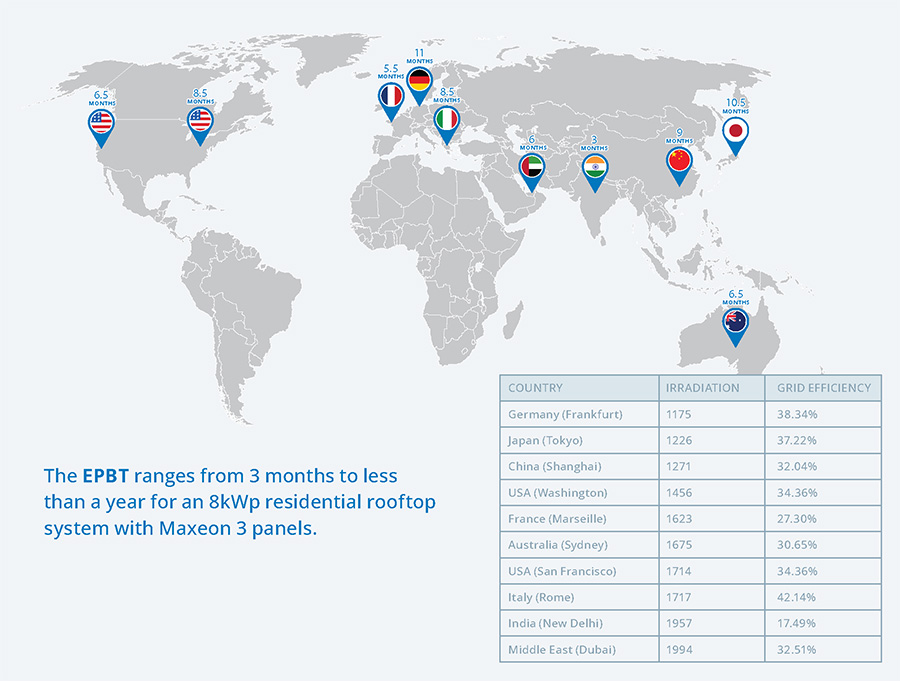Shopping for Solar? Here’s how to make the most sustainable choice for your home

Choosing to go solar is one of the most environmentally responsible decisions you can make. The sustainable benefits of reducing carbon emissions and enjoying energy independence are well known. But are all solar technologies the same when it comes to their environmental footprint?
To understand a solar panel’s true impact on the earth, we have to look at its entire product lifecycle: from extraction of raw materials to manufacturing, transportation, use and disposal at the end of its life. One way to measure this lifecycle approach is to look at the “Energy Payback Time” (EPBT).
While the acronym EPBT may seem like alphabet soup, don’t let that deter you. Knowing how much energy a solar panel uses – and produces – during its warrantied lifetime is one way to compare different solar technologies on an apples-to-apples basis.
What is Energy Payback Time?
Simply stated, EPBT indicates the time period required for a renewable energy system to generate the same amount of energy that was used to produce and utilize the system itself. (It is different from economic payback time, which indicates how long your investment will take to pay for itself).
EPBT is typically expressed as the number of years it will take to “pay back” the energy a solar energy system uses over its lifetime. Because it considers the entire lifecycle of the solar panel, EPBT is a highly regarded measure of a solar panel’s impact on the planet.
New Independent Study Shows Maxeon 3 Excels on EPBT
When it comes to comparing solar panels on EPBT, there are some fairly big differences, according to a new independent study from Fraunhofer Institute for Solar Energy Systems (ISE). For example, an 8 kWp residential rooftop system with Maxeon 3 modules installed in France showed an EPBT 28% lower when compared to a system with PERC technology – the mainstream technology available today.
This means it took 28% less time to “pay back” the energy used over the system’s lifetime compared with the alternative. The system with Maxeon 3 panels earned its EPBT advantage mainly thanks to Maxeon 3 panel’s higher efficiency as well as the lower energy demand in producing the panel itself. The search for the panel’s energy sobriety began right from the design of the panel.
After the first months, a Maxeon solar panel returns positive environmental benefits for 39 years or more, especially when considering that Maxeon technology has the potential to perform beyond the panel’s industry-leading 40-year warranty.1 The 40-year warranty applies to residential systems.
The EBPT was assessed following the framework and recommendations of the International Energy Agency (IEA) PVPS 12 ‘Methodology Guidelines for LCA on PV’.2 Frischknecht, R., Stolz, P., Krebs, L., Wild-Scholten, M. de and Parikhit Sinha (2020) Life Cycle Inventories and Life Cycle Assessment of Photovoltaic Systems, 2020 Task 12 PV Sustainability: Report IEA-PVPS T12-19:2020.
Ask your installer about the product lifecyle and sustainability of your future panels
When shopping for solar, it’s important to consider all the actions taken by the manufacturer to deliver the system to your door, from the materials in the solar panels to their eventual disposal many years later. Just as you look at the composition of food products or cosmetics and how their packaging may be recycling (or not), ask your installer what your panels are made of, and whether they can be recycled at the end of life.
Maxeon panels go through the rigorous evaluation of the Cradle-to-Cradle institute in the areas of material health, material reutilization, renewable energy and carbon management, water stewardship, and social fairness and are certified Silver. All ingredients used in its composition are listed and registered under the Declare Label. This supports recycling and prevents used panels from going to landfills. We work at a local level with recycling experts in the countries we operate.
In the race against climate change, individual actions can help make concrete progress, step by step. When it comes to energy, it is imperative to ensure that the solar panels you choose are as sustainable as the energy they generate.
